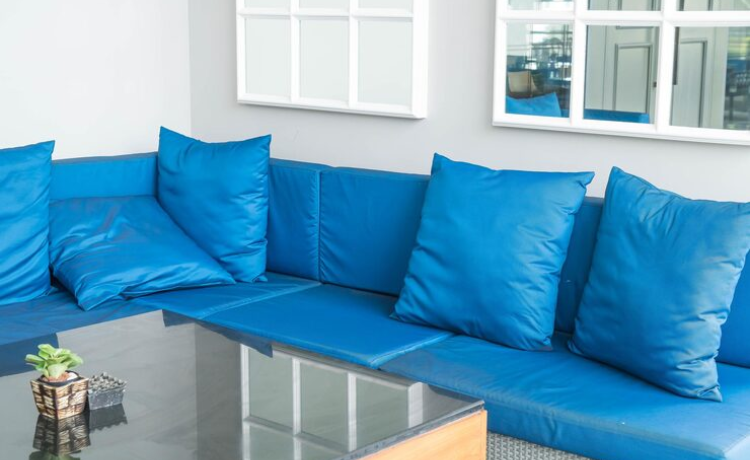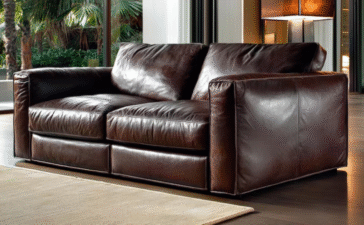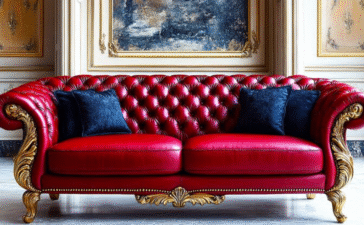Your sofa represents a significant investment in your home’s comfort and style. Whether you spent hundreds or thousands of dollars on that perfect sectional, protecting it from daily wear, spills, and pet damage becomes a priority. Plastic sofa covers have emerged as one of the most practical and cost-effective solutions for furniture protection, gaining popularity among homeowners who want to preserve their investment without compromising on functionality.
Interior design experts and furniture manufacturers increasingly recommend protective covers as a preventative measure rather than waiting for damage to occur. According to recent furniture industry data, the average American household replaces their main living room sofa every 7-10 years, with premature replacement often triggered by stains, pet damage, or excessive wear rather than structural failure.
This comprehensive guide will help you understand everything about plastic sofa covers, from material types and installation methods to choosing the perfect fit for your specific needs. You’ll discover how these protective solutions can extend your furniture’s lifespan, maintain your home’s aesthetic appeal, and provide peace of mind for families with children and pets.
By the end of this article, you’ll have expert-level knowledge to make an informed decision about whether plastic sofa covers are right for your home and how to select the best option for your unique situation.
Understanding Plastic Sofa Covers: Materials and Construction
Plastic sofa covers are protective barriers designed to shield your furniture from spills, stains, pet damage, and general wear. These covers are manufactured using various plastic materials, each offering distinct advantages depending on your specific protection needs.
The most common material used in quality plastic sofa covers is Low-Density Polyethylene (LDPE), which provides flexibility and durability while maintaining transparency. LDPE covers offer excellent resistance to moisture and are relatively soft to the touch, making them comfortable for regular use. Another popular option is Polyvinyl Chloride (PVC), which tends to be more rigid but offers superior puncture resistance, making it ideal for households with pets that have sharp claws.
Clear vinyl sofa covers represent the premium segment of plastic furniture protection. These covers use high-grade vinyl that maintains optical clarity while providing robust protection against spills and stains. Unlike basic plastic options, clear vinyl covers often feature enhanced UV resistance, preventing yellowing and degradation from sunlight exposure.
Heavy-duty plastic sofa covers cater to high-traffic households or commercial environments where furniture faces constant use. These covers typically use thicker gauge materials, ranging from 4-6 mil thickness compared to standard 2-3 mil options. The increased thickness provides superior tear resistance and longevity, though it may sacrifice some flexibility and comfort.
Custom plastic slipcovers offer tailored protection for unique furniture shapes and sizes. These covers are manufactured to precise measurements, ensuring a snug fit that doesn’t shift or bunch during use. Custom options often incorporate elastic edges or drawstring closures to maintain proper positioning.
Stretchable elastic plastic covers combine the protection of plastic with the convenience of fabric-style installation. These covers feature elastic panels or bands that allow them to conform to various sofa shapes while maintaining protective coverage.
Why Plastic Sofa Covers Are Essential for Modern Homes
Waterproof plastic sofa covers provide unmatched protection against liquid spills, which represent the most common cause of permanent furniture damage. Unlike fabric covers that may absorb spills despite water-resistant treatments, plastic creates an impermeable barrier that completely prevents liquids from reaching your sofa’s upholstery. This protection proves invaluable during entertaining, family meals, or simply daily living with beverages and food nearby.
Pet owners face unique furniture protection challenges that plastic covers address effectively. Pet proof plastic sofa covers resist punctures from claws while preventing pet hair from embedding in upholstery fibers. The smooth surface of plastic covers makes removing pet hair simple with basic wiping or light vacuuming, unlike fabric covers that can trap hair permanently.
Beyond pet hair, plastic covers protect against pet accidents, which can cause permanent odor and staining in traditional upholstery. The waterproof nature of these covers ensures that any accidents stay on the surface for easy cleanup, preventing absorption into cushion foam or fabric fibers.
Easy-to-clean plastic covers eliminate the maintenance burden associated with fabric protection options. While traditional slipcovers require removal and washing, often shrinking or losing shape in the process, plastic covers clean with simple wiping using mild soap and water. This convenience makes them ideal for busy households where frequent cover washing isn’t practical.
Protective plastic covers for sofas extend furniture lifespan significantly by preventing the accumulation of dirt, oils, and debris that cause fabric deterioration. Upholstery fabrics naturally collect particles and oils from daily use, leading to gradual discoloration and fiber breakdown. By creating a barrier between users and the original upholstery, plastic covers preserve the pristine condition of your furniture for years longer than unprotected pieces.
Selecting the Perfect Plastic Sofa Cover for Your Home
Proper measurement forms the foundation of successful plastic sofa cover selection. Start by measuring your sofa’s width from arm to arm at the widest point, typically across the front. Record the depth from the back of the sofa to the front edge of the seat cushion. Measure the height from the floor to the top of the back cushions, including any decorative elements that extend upward.
For sectional sofas, measure each section individually and note the configuration. L-shaped sectionals require covers designed specifically for corner arrangements, while straight sectionals may accommodate multiple individual covers or single extended pieces designed for sectional coverage.
Custom-sized plastic sofa covers offer the most precise fit, eliminating bunching and shifting that can occur with one-size-fits-all options. Many manufacturers provide measurement guides and even offer consultation services to ensure proper sizing. The investment in custom sizing typically pays off through improved appearance and functionality.
Fitted elastic plastic sofa covers provide convenience for users who prefer easy installation and removal. These covers feature elastic edges or bands that stretch around the sofa frame, creating tension that holds the cover in place. While not as precise as custom options, elastic covers accommodate minor variations in furniture dimensions and work well for standard-sized sofas.
Loose fit covers offer more versatility for irregularly shaped furniture or multi-use applications. These covers can be tucked, folded, or adjusted to provide coverage for various furniture styles. While they may require more frequent adjustment, loose covers often cost less and can adapt to furniture changes or replacements.
Aesthetic integration requires balancing protection with visual appeal. Transparent plastic sofa covers maintain your furniture’s original appearance while providing protection, making them ideal for showcasing beautiful upholstery patterns or colors. For furniture with less attractive upholstery or for temporary protection during events, opaque plastic covers can actually improve the room’s appearance while providing superior protection.
Specialized Plastic Covers for Different Household Needs
Families with children require waterproof and spill-resistant plastic sofa covers that can handle the inevitable accidents and messes that come with young family members. These covers should feature smooth surfaces that don’t trap crumbs or sticky substances, allowing for quick cleanup after meals or snacks consumed on the sofa. Look for covers with antimicrobial treatments that prevent bacterial growth from food residues or spills.
Households with multiple pets or large dogs benefit from scratch-resistant plastic sofa covers manufactured with thicker materials and reinforced stress points. These covers often incorporate puncture-resistant additives that maintain integrity even when subjected to repeated claw contact. Some specialized pet-oriented covers feature textured surfaces that provide better grip for pets while maintaining easy cleaning for owners.
Moving and storage situations require plastic furniture covers designed for long-term protection against dust, moisture, and physical damage during transport. These covers typically use heavier gauge materials and may incorporate UV inhibitors to prevent degradation during outdoor storage. Storage covers often feature larger dimensions to accommodate the protective wrapping required during moving processes.
Style-conscious homeowners can choose from decorative plastic covers that blend protection with aesthetic enhancement. Some manufacturers offer printed or colored plastic options that can complement existing decor while providing functional protection. These covers may feature subtle patterns or textures that reduce the clinical appearance often associated with clear plastic protection.
Commercial and high-traffic applications benefit from commercial-grade plastic sofa covers designed to withstand constant use and frequent cleaning. These covers often exceed residential thickness standards and may incorporate flame-retardant additives required in commercial settings.
Advantages and Limitations of Plastic Sofa Protection
The primary advantage of plastic sofa covers lies in their comprehensive protection against liquids, stains, and spills. Unlike fabric covers that may still allow some penetration, quality plastic creates an absolute barrier that prevents any liquid from reaching your furniture’s upholstery. This protection proves invaluable for households with children, frequent entertaining, or anyone who enjoys eating or drinking while using their sofa.
Cost-effectiveness represents another significant advantage, especially when compared to professional upholstery cleaning or furniture replacement. A quality plastic cover typically costs less than a single professional cleaning session while providing ongoing protection that can prevent numerous cleaning needs. When compared to reupholstering damaged furniture, the cost savings become even more dramatic.
Maintenance simplicity makes plastic covers attractive for busy households. The ability to clean spills with a simple wipe eliminates the time and effort required for fabric cover washing, drying, and reinstallation. This convenience encourages consistent use, maximizing the protective benefits.
However, plastic covers do present some limitations that potential users should consider. Comfort can be compromised, particularly with lower-quality covers that may feel sticky or create noise when users shift position. Higher-quality covers with softer plastics and better manufacturing can minimize these issues, but they never completely eliminate the difference in feel compared to fabric surfaces.
Temperature sensitivity affects both comfort and durability. Plastic covers can feel cold in winter and may become uncomfortably warm in hot weather or direct sunlight. This characteristic makes them less suitable for year-round use in some climates or room configurations.
Static electricity buildup can attract dust and pet hair to plastic surfaces, potentially requiring more frequent cleaning than expected. Anti-static treatments available on some covers can reduce this issue but may add to the overall cost.
Aesthetic limitations remain a consideration for design-conscious homeowners. While clear covers preserve the original furniture appearance, they still create a barrier that changes the tactile and visual experience of the furniture. Some users find the clinical appearance of plastic covers incompatible with their desired home atmosphere.
Where to Purchase Quality Plastic Sofa Covers
Online marketplaces offer the widest selection of plastic sofa covers, with platforms like Amazon providing access to numerous manufacturers and price points. Online shopping allows easy comparison of features, prices, and customer reviews, helping buyers make informed decisions. However, the inability to physically examine materials before purchase can lead to disappointment with texture or quality.
Specialty furniture protection retailers often provide higher-quality options and expert guidance for specific protection needs. These retailers typically offer detailed product specifications and may provide custom sizing services. The trade-off usually involves higher prices compared to general marketplaces, but the specialized expertise can justify the additional cost.
Local furniture stores sometimes carry basic plastic cover options and can provide immediate availability for urgent protection needs. However, selection may be limited, and prices often exceed online alternatives. The advantage lies in the ability to examine materials firsthand and receive immediate assistance with sizing questions.
Wholesale plastic slipcovers become cost-effective for businesses or individuals needing multiple covers. Wholesale purchasing requires larger minimum orders but can provide significant per-unit savings. Commercial buyers often choose wholesale options when outfitting rental properties or commercial seating areas.
Manufacturing direct purchases eliminate retailer markups while ensuring product authenticity. Many plastic cover manufacturers now sell directly to consumers through their websites, offering better pricing and access to the full product range. Direct purchasing often provides access to customization options not available through retailers.
Frequently Asked Questions
How do you properly install plastic sofa covers without wrinkles or bunching?
Installing plastic sofa covers requires patience and proper technique to achieve a smooth, professional appearance. Begin by ensuring your sofa is clean and completely dry, as any moisture can create adhesion issues. Start installation from the back of the sofa, draping the cover over the highest point and allowing it to fall naturally toward the front. For fitted covers, work the elastic edges around the sofa frame gradually, maintaining even tension to prevent bunching. Smooth out air bubbles and wrinkles by working from the center toward the edges using your hands or a soft cloth. For loose-fit covers, take time to adjust and tuck excess material into crevices between cushions and frame elements. Professional installers recommend working in sections rather than trying to position the entire cover at once.
Are plastic sofa covers comfortable enough for daily use?
Comfort levels vary significantly based on the plastic type, thickness, and manufacturing quality of the cover. High-quality vinyl and LDPE covers with soft-touch finishes can provide reasonable comfort for daily use, while basic PVC covers may feel stiff or sticky against skin. Temperature plays a crucial role in comfort, as plastic covers can feel cold in winter and warm in summer. Many users find comfort improves with a thin throw blanket or decorative pillows that create a barrier between users and the plastic surface. Breathable plastic options incorporate micro-perforations that allow air circulation while maintaining liquid protection, significantly improving comfort levels. Users sensitive to plastic contact should consider covers with fabric-like textures or hybrid options that combine plastic protection with fabric comfort layers.
What is the proper way to clean and maintain plastic sofa covers?
Cleaning plastic sofa covers requires gentle techniques to maintain material integrity and appearance. For routine cleaning, use a mild soap solution with warm water applied with a soft cloth or sponge. Avoid harsh chemicals, abrasive cleaners, or scrubbing pads that can damage the plastic surface or cause clouding in clear covers. For stubborn stains, create a paste using baking soda and water, apply gently, and rinse thoroughly. Disinfection can be achieved using diluted bleach solutions, but test in an inconspicuous area first to ensure compatibility. After cleaning, allow covers to air dry completely before repositioning to prevent moisture entrapment. Regular maintenance includes checking for tears or punctures that could compromise protection and addressing issues promptly with plastic repair kits designed for furniture covers.
How long can you expect plastic sofa covers to last with regular use?
Lifespan expectations for plastic sofa covers depend heavily on material quality, usage intensity, and environmental factors. High-quality vinyl covers with UV protection can last 3-5 years with daily use in typical household conditions. Medium-grade LDPE covers typically provide 2-3 years of service, while budget PVC options may require replacement annually. Factors that reduce lifespan include direct sunlight exposure, extreme temperature fluctuations, sharp objects contact, and aggressive cleaning methods. Commercial-grade covers designed for high-traffic environments often last longer than residential options due to thicker materials and enhanced durability treatments. Signs that replacement is needed include persistent clouding, tears that cannot be repaired, permanent staining, or loss of elasticity in fitted covers. Proper care and protection from environmental stressors can extend cover life significantly beyond average expectations.
Are there environmentally friendly plastic sofa cover options available?
The furniture protection industry has responded to environmental concerns by developing several eco-friendly plastic cover alternatives. Biodegradable plastic covers manufactured from plant-based materials like corn starch or sugarcane offer protection while breaking down naturally at end-of-life. Recycled content covers incorporate post-consumer plastic waste, reducing environmental impact while maintaining protective functionality. Some manufacturers offer take-back programs that ensure proper recycling of used covers rather than landfill disposal. Bio-based vinyl alternatives derived from renewable resources provide similar performance to traditional petroleum-based options with reduced carbon footprints. However, eco-friendly options often cost more than conventional covers and may have shorter lifespans. Users prioritizing environmental responsibility should research manufacturer certifications and end-of-life disposal options when selecting covers.
Can plastic sofa covers be used on leather furniture safely?
Plastic sofa covers can be used on leather furniture, but special considerations apply to prevent damage to the leather surface. Leather requires air circulation to maintain its natural oils and prevent cracking, so non-breathable plastic covers should only be used temporarily. Extended use of impermeable covers can trap moisture and cause leather to develop mold, mildew, or deterioration. Perforated plastic covers or those specifically designed for leather provide protection while allowing necessary air circulation. Before installation, ensure the leather is clean and treated with appropriate conditioners, as plastic covers will prevent access for regular leather maintenance. Temperature considerations become more critical with leather, as trapped heat can cause leather oils to migrate and potentially stain the plastic cover. For valuable leather furniture, consider consulting with leather care professionals before using plastic protection.
What thickness of plastic provides the best balance of protection and comfort?
Plastic cover thickness, measured in mils (thousandths of an inch), directly affects both protective capability and user comfort. Standard residential covers typically range from 2-6 mils thickness, with each range serving different needs. Ultra-thin 2-3 mil covers provide basic spill protection with minimal impact on furniture feel but offer limited durability against tears or punctures. Medium-weight 4-5 mil covers represent the optimal balance for most households, providing adequate protection against normal wear while maintaining reasonable flexibility and comfort. Heavy-duty 6+ mil covers excel in high-traffic situations or homes with large pets but may feel stiff and uncomfortable for regular sitting. The material type affects these characteristics significantly, with high-quality vinyl maintaining comfort at greater thicknesses compared to basic PVC. Users should consider their primary protection needs when selecting thickness, prioritizing comfort for daily-use furniture and durability for occasional-use or high-risk situations.
You should also check: “manual reclining sofa“
Making the Right Choice for Your Furniture Protection Needs
Plastic sofa covers represent a practical and cost-effective solution for protecting your furniture investment while maintaining functionality and style. The key to success lies in understanding your specific needs, from the level of protection required to the balance between durability and comfort that works for your household.
Quality plastic covers can extend your sofa’s lifespan by years while providing peace of mind for families with children, pets, or active lifestyles. The upfront investment in a well-made cover pays dividends through prevented damage, reduced cleaning costs, and preserved furniture value.
Consider your household’s unique characteristics when making your selection. Families with young children will benefit most from waterproof options with easy cleaning properties, while pet owners should prioritize scratch-resistant materials and secure fitting systems. Style-conscious homeowners can find options that protect without compromising their interior design vision.
Take the time to measure your furniture accurately and research manufacturers that offer the features most important to your situation. Whether you choose transparent protection that showcases your furniture’s beauty or opt for decorative covers that enhance your room’s appearance, the right plastic sofa cover will provide years of reliable protection while maintaining the comfort and functionality your family expects from this important furniture investment.












